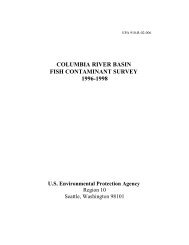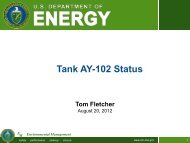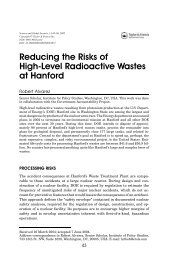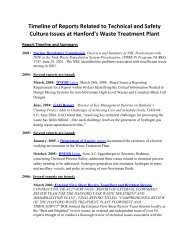Knowing Endangerment - Hanford Challenge
Knowing Endangerment - Hanford Challenge
Knowing Endangerment - Hanford Challenge
Create successful ePaper yourself
Turn your PDF publications into a flip-book with our unique Google optimized e-Paper software.
With the failure to record this information on a standardized form and to upload this information into<br />
the DRI database, there is nothing to prove that any measurements were even taken, much less taken<br />
accurately. Consequently, the integrity of any such data is suspect. Additionally, as discussed<br />
earlier, data that is uploaded into the database is often so poorly retained, catalogued, and reviewed<br />
that it is unlikely to add up to a comprehensive story of exposure.<br />
CHG and CCSI are now contesting Lewis‟ workers‟ compensation claim by arguing that he was not<br />
exposed to the levels he claims, when in fact CHG failed to follow its own monitoring procedures<br />
that should have documented his exposure levels.<br />
CHG consistently fights worker compensation claims following exposures, even when doctors have<br />
claimed that illnesses are the result of exposures. CHG fought another electrician‟s worker‟s<br />
compensation claim (for consistent nosebleeds and chemical rhinitis), in spite of “work related”<br />
diagnoses from two of the three CCSI-referred physicians and from a fourth physician at Harborview<br />
Medical Center‟s Occupational and Environmental Medicine Program in Seattle. In fact, following<br />
pressure from the lawyer representing CHG and CCSI‟s interests, two of the three CCSI-referred<br />
“Independent Medical Examiners” changed their original conclusions of “work related” symptoms to<br />
“not work related.” The electrician‟s L & I claim was denied.<br />
Interestingly, Harborview recently wrote a letter to CHG‟s Vice President asking a number of<br />
questions pertaining to, among other issues, outdated tank vapor characterization data, 126<br />
questionable industrial hygiene practices, 127 and CHG‟s reasons for not requiring supplied air when<br />
employee exposure cannot be reasonably identified or estimated The author of the letter went on to<br />
explain:<br />
Given my limited understanding of the chemical instability of the Tank Farms tanks;<br />
the presence of high concentrations of ammonia and nitrous oxide in the tank<br />
headspace, as well as a complex mixture of over 40 chemicals (including<br />
carcinogens); the opportunities for leakage through openings in close proximity to the<br />
worker‟s breathing zone; and the limitations of the waste tanks profiles, I would<br />
recommend the use of supplied air respiratory protection for employees working in<br />
close proximity to these tanks in the Farms. This is why I am interested in your<br />
exposure assessment approach and respiratory protection selection rationale. 128<br />
A Chilled Work Environment<br />
Workers who do complain about exposures and actively seek protective equipment have been<br />
subjected to a pattern and practice of retaliation, reprisal, and various humiliations - all which create<br />
a chilling and hostile working environment and deter reports of safety violations and medical injuries<br />
at <strong>Hanford</strong> tank farms. Some workers have filed formal complaints with the Department of Labor<br />
126 Letter from Nancy Beaudet MS, CIH, Industrial Hygienist at Harborview‟s Occupational and Environmental<br />
Medicine Program to Kathy Lombard, Vice President, CHG, July 24, 2003 (“The waste tank chemical profiles were<br />
conducted over 7 year [sic] ago. Is there more recent information?”).<br />
127 Id. (“Why was the scope of the exposure assessment limited to ammonia? I understand ammonia is present at<br />
high concentrations in the headspace and likely serves as a good warning chemical. However, since carcinogens,<br />
nitrous oxide, a significant number of irritants, and other chemicals are also documented in the Tank Profile, a more<br />
comprehensive exposure assessment seems reasonable.” (internal citations omitted))<br />
128 Id. (Internal Citations Omitted).<br />
28







